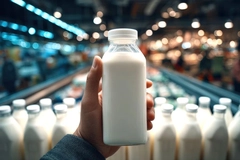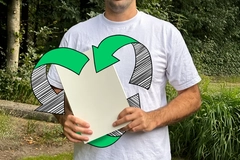Preserving freshness: Vidre+ Technology prolongs arugula shelf life by 24 days

19 Feb 2024 --- A recent study has proven that new technology, known as Vidre+, has the ability to extend the shelf life of leafy greens by multiple days. The innovation uses ethylene gas inhibiting stickers that release 1-Methylcyclopropene (1-MCP) — a plant growth regulator — to offer a new solution to the perennial problem of premature spoilage that can help the industry to battle against food waste.
Leafy greens, such as arugula and spinach, are staple ingredients but often spoil during shipment or on the store shelf. This is part of the wider problem of food waste, which is further compounded by the escalating demand for fresh produce, driven by growing health-conscious consumer trends.
Tim Malefyt, CTO at Fresh Inset, tells Food Ingredients First: “Food waste represents a big challenge and often is called the third biggest greenhouse emitter globally and a large percentage of food waste worldwide consists of fruits and vegetables.”
“Vidre+ technology enhances the freshness and quality of produce and has the potential to save up to 9.46 million tons of fruits and vegetables annually. It stands out for its effectiveness in addressing food waste and reducing CO2 emissions, preventing the wastage of 4.2 million tons of CO2 footprint.”
Innovation on food preservation and packaging
Vidre+ technology employs simple yet effective stickers placed inside the packaging to mitigate the effects of ethylene gas, a natural plant hormone responsible for ripening fruits and vegetables. By slowly releasing 1-MCP, a substance commonly used in the produce industry to slow down ripening, Vidre+ keeps fruits and leafy greens fresher for longer.
 Treated leafy greens kept very good eating quality and firmness (Image credit: Fresh Inset).With Vidre+ stickers, no additional equipment or special storage conditions are needed. Its affordability and simplicity make Vidre+ a practical solution with the potential for widespread adoption.
Treated leafy greens kept very good eating quality and firmness (Image credit: Fresh Inset).With Vidre+ stickers, no additional equipment or special storage conditions are needed. Its affordability and simplicity make Vidre+ a practical solution with the potential for widespread adoption.
“Vidre+ outperforms all existing post-harvest solutions by extending fresh produce shelf life by days to months, depending on the type of crop,” says Malefyt.
According to him, the technology works on raspberries, pears, apples, avocados, blueberries, tomatoes, leafy greens, and many other crops. Last year, the company also commissioned trials of its stickers on Champignon mushrooms.
“Vidre+ technology changes existing types of fresh produce packaging and label into functional and smart versions. It benefits every stakeholder in the fresh produce supply chain,” he continues.
“It grants producers and suppliers across the supply chain the opportunity to reduce costs in nearby shipments and explore new export markets. Vidre+ technology can also slow the degradation of fruits, thereby preserving their quality, nutritional value, and most importantly, their fresh appearance, which encourages customers to make a purchase.”
Study highlights and global expansion
A recent study led by researchers at the University of Life Sciences in Bydgoszcz, Poland, commissioned by Fresh Inset, showcased the impact of Vidre+ technology on leafy greens.
Key findings from the study include an extension of arugula’ shelf life to 24 days and spinach to 10 days, along with enhanced preservation of quality attributes such as reduced wilting, weight loss and maintained visual appeal.
Furthermore, Vidre+ treatment resulted in higher chlorophyll retention in spinach and received higher Visual Quality Ratings, influencing consumer preferences and choices positively.
Already in use in Argentina, Vidre+ is poised to make its mark on global markets pending regulatory approval in key regions, including the Americas.
“Due to the simplicity of using Vidre+ technology in all sorts of packaging systems, the adoption rate from the logistics standpoint is not considered a big challenge. Each adopter will have to determine for themselves how best to use it.”
“Our approach with all packers and suppliers is to show them the benefits we have seen in our global R&D trials, have them validate the benefits in their supply chain situation, and then determine if they want to adopt the technology,” concludes Malefyt.
By Sichong Wang











